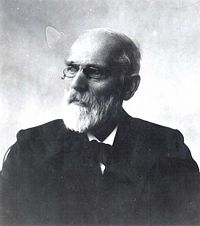PHZ3400 Phase Transition: Difference between revisions
Jump to navigation
Jump to search
MatthewHoza (talk | contribs) |
MatthewHoza (talk | contribs) |
||
| Line 11: | Line 11: | ||
[[Image:Johannes_Diderik_van_der_Waals.jpg|thumb|right|200px|Lennard-Jones potential. Johannes Diderik van der Waals]] | [[Image:Johannes_Diderik_van_der_Waals.jpg|thumb|right|200px|Lennard-Jones potential. Johannes Diderik van der Waals]] | ||
<math>P = \frac{T}{\nu b} - \frac{a}{\nu^2} | <math>P = \frac{T}{\nu b} - \frac{a}{\nu^2}\!</math> | ||
where <math>\nu \equiv \frac{N}{V} | where <math>\nu \equiv \frac{N}{V}\!</math> | ||
Revision as of 14:13, 27 January 2009
Phases of Matter
Matter can exist in many phases. The phases most common are solids, liquids, and gases. In Physics, a phase can be described as a region of space in which all physical properties of a material remain constant, or uniform. Having consistent physical properties and chemical uniformity allow one to distinguish between the various phases, or states of matter.
Gas-Liquid-Solid Phase Diagram
Phase Separation and Nucleation
This we'll cover on Friday, Jan. 30
Why Ice Floats? Consequences.
Van der Walls Equation
where


